Three Parallel Rivers of Yunnan Protected Areas–UNESCO World Natural Heritage

Attraction Overview
Three Parallel Rivers Natural Reserve is a UNESCO World Heritage Site, which lies within the drainage basins of the upper reaches of the Yangtze (Jinsha), Lancang (Mekong) and Nujiang (Salween) rivers, in the Yunnan section of the Hengduan Mountains.
Attraction Type: Nature Reserve
Chinese Name: 三江并流自然保护区(Pinyin: Biluo Xueshan)
Best Time to Visit: All-year-round
Location: Northwest of Yunnan Province, China
Why is Three Parallel Rivers Natural Reserve So Special?
Three Parallel Rivers Natural Reserve is a UNESCO World Heritage Site, a nature reserve extending over 170,000 km2 within the undulating mountains of northwest Yunnan Province. It is the combination of seven geographical features over eight geographic regions. The whole reserve is composed of the drainage areas of the three great rivers – Nu River, Lancang River, Jinsha River, and the mountains around. It is a very rare phenomenon that the shortest distance between the Lancang River and Jinsha River is only 66 kilometers and between the Lancang River and Nu River the distance is less than 19 kilometers. It is also the inhabiting place of 16 ethnic groups. Different nationalities, languages, religions and customs co-exist, making it a special and unique region rarely seen in the world.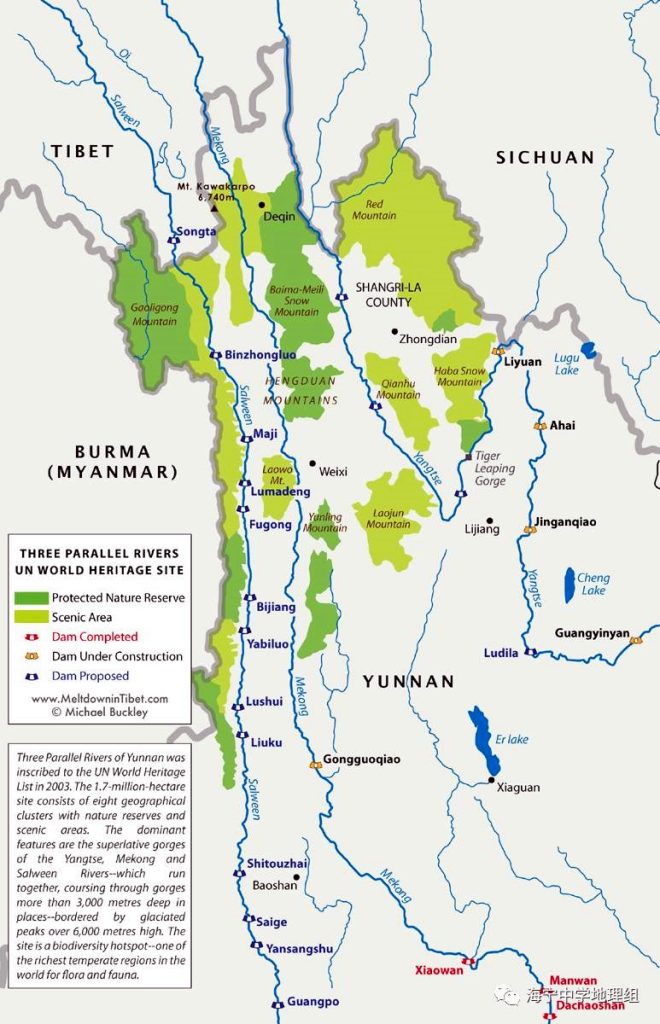
Where is Three Parallel Rivers Natural Reserve – Location
It lies within the drainage basins of the upper reaches of the Yangtze (Jinsha), Lancang (Mekong) and Nujiang (Salween) rivers, in the Yunnan section of the Hengduan Mountains. It covers three autonomous prefectures and cities, including Lijiang City, Diqing Tibetan Autonomous Prefecture and Nujiang Lisu Autonomous Prefecture of Yunnan Province.
About the Three Parallel Rivers
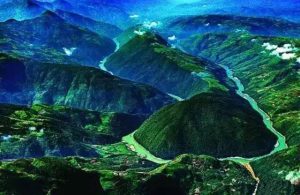
The natural landscape comprises three great rivers of East Asia, namely, the Jinsha River (the upper reaches of the Yangtze River), the Lancang River (the upper reaches of the Mekong River), and the Nujiang River (the upper reaches of the Salween River). Originating in the Tanggula Mountain on the Qinghai-Tibet Plateau, the three rivers flow parallel along the Hengduan Mountains for several hundred kilometers.
The Mekong runs through a gorge 310 km long. It crosses both Cambodia and Vietnam, and is the source of much of the food supply in both countries. The Yangtze River is China’s largest riverand the world’s 6th biggest. It stretches from here through Chongqing and Wuhan and ends at Shanghai. The Salween is important for the livelihood of the ethnic people in Burma and Thailand. The river valley in Burma is known for its beauty, and it flows to the Indian Ocean.
Geologic Origin of Three Parallel Rivers
The Three Parallel Rivers of Yunnan Protected Areas is representative of landscapes demonstrating the Earth’s evolution over major geological time periods and bio-evolution at important phases. In ancient times, as a result of the collision between India Plate and Eurasian Plate, the Qinghai-Tibet Plateau was ballooned up, creating the parallel mountains and rivers within a length of 150 kilometers, including the Dulong River, Gaoligong Mountain, Nu River, Lancang River, Yunling Mountain and Jinsha River in this area. Therefore the natural sceneries here are quite unique not only in China, but also in the world.
Features of Three Parallel Rivers Natural Reserve
The natural scenery of Three Parallel Rivers is located at the deep narrow valleys in the mountainous areas of the southern part of Qinghai-Tibet Plateau, in southwest China’s Yunnan Province. On this piece of land, there are high mountains, deep valleys, snow-capped peaks, large glaciers, lakes with potable water, wild forest, marshy grassland, rare animals and precious plants.
The height of snow-covered mountains in this area varies from 2,000 meters to 6,000 meters, and there are over 100 snow-covered mountains higher than 5, 000 meters, with Meili Snow Mountain as the top one. The deep gorges of Nu River Gorge(eg. Oriental Grand Gorge), Lancang River Gorges and Jinsha River Gorges(eg. Tiger Leaping Gorge) are particularly famous. There are 20% Higher Plants and over 25% more animals in this area including Yunnan golden monkeys, antelopes, snow leopards, Bengalese tigers and black necked cranes.
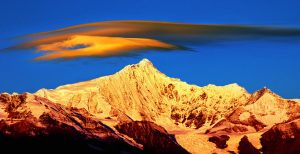
Its demographic make-up also is highly interesting as it contains many of the twenty-five minorities found in Yunnan province including the Derung, the smallest of all of China’s minority groups. Some of the other minorities found in this region are the Tibetan people, the Nu people, Lisu, Bai, Pumi and Naxi. Many of these minorities still use traditional costumes as their normal daily attire.
How to Get to Three Parallel Rivers Natural Reserve
To Lijiang City:
Lijiang is easily reachable since becoming a popular tour destination at the end of the 1990s. Tourists can take flight, train or coach getting there. More info please refer to Lijiang Transportation.
To Diqing Prefecture:
With a small regional airport, Shangri-La mainly relies on its roads as the main means of transportation. Tourists can take the flight or coach getting there. More info please refer to Diqing Transportation.
To Nujiang Prefecture:
Tourists need to get to Liuku in Nujiang Lisu Autonomous Prefecture first, and then take the local bus to Fugong, Gongshan and Bingzhongluo Village. This itinerary gives visitors a chance to explore the Nu River Gorge. More info please refer to Nujiang Transportation.
 Main Attractions
Main Attractions
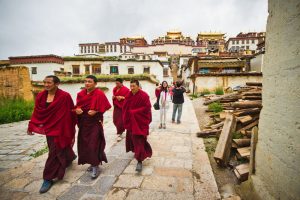
Shangri-La
Shangri-La is depicted as “Eden in dream” by British novelist James Hilton’s Lost Horizon in the 1939, a famous area with numerous natural landscapes and unique Tibetan customs. The main attractions in Shangrila include Songzanlin Lamasery, Pudacuo National Park, Meli Snow Mountain, Baishuitai, Tiger Leaping Gorge, etc.
Lijiang City
Lijiang, a popular destination in Yunnan, is considered as a fairyland blessed with fresh air, clear streams, breathtaking snow mountains and an undisturbed landscape inhabited by a friendly group of people. The main attractions include Lijiang Old Town, Jade Dragon Snow Mountain, Tiger Leaping Gorge, Lashi Lake, Lugu Lake, etc.
Nujiang Area
There are much to see or to do in Nujiang. Minorities in Nujiang is the most diverse in China and the population of minorities is the largest. The main attractions include Nujiang Grand Canyon, Bingzhongluo scenic Area, Gaoligongshan Mountain, Dulongjiang valley, etc.
Tours including Three Parallel Rivers Natural Reserve
10 Days Three Parallel Rivers Circle Tour with Nanjiluo and Biluo Snow Mountain Hiking
12 Days Yunnan Three Parallel Rivers Overland Tour with Biluo and Meili Snow Mountains
13 Days Three Parallel Rivers Circle Adventure with Tiger Leaping Gorge and Yubeng Village Hiking Tour
15 Days Three Parallel Rivers Overland Adventure with Dulongjiang River Valley and Tiger Leaping Gorge Hiking
20 Days Yunnan Three Parallel Rivers Adventure Trekking Tour
46 Days Yunnan Panorama Photography Tour with 25 Ethnic Minorities Discovery and Three Parallel Rivers Hiking Adventure

 7 Days GolfingTour
7 Days GolfingTour
 8 Days Group Tour
8 Days Group Tour
 8 Days Yunnan Tour
8 Days Yunnan Tour
 7 Days Shangri La Hiking
7 Days Shangri La Hiking
 11 Days Yunnan Tour
11 Days Yunnan Tour
 6 Days Yuanyang Terraces
6 Days Yuanyang Terraces
 11 Days Yunnan Tour
11 Days Yunnan Tour
 8 Days South Yunnan
8 Days South Yunnan
 7 Days Tea Tour
7 Days Tea Tour
 8 Days Muslim Tour
8 Days Muslim Tour
 12 Days Self-Driving
12 Days Self-Driving
 4 Days Haba Climbing
4 Days Haba Climbing
 Tiger Leaping Gorge
Tiger Leaping Gorge
 Stone Forest
Stone Forest
 Yunnan-Tibet
Yunnan-Tibet
 Hani Rice Terraces
Hani Rice Terraces
 Kunming
Kunming
 Lijiang
Lijiang
 Shangri-la
Shangri-la
 Dali
Dali
 XishuangBanna
XishuangBanna
 Honghe
Honghe
 Kunming
Kunming
 Lijiang
Lijiang
 Shangri-la
Shangri-la
 Yuanyang Rice Terraces
Yuanyang Rice Terraces
 Nujiang
Nujiang
 XishuangBanna
XishuangBanna
 Spring City Golf
Spring City Golf
 Snow Mountain Golf
Snow Mountain Golf
 Stone Mountain Golf
Stone Mountain Golf
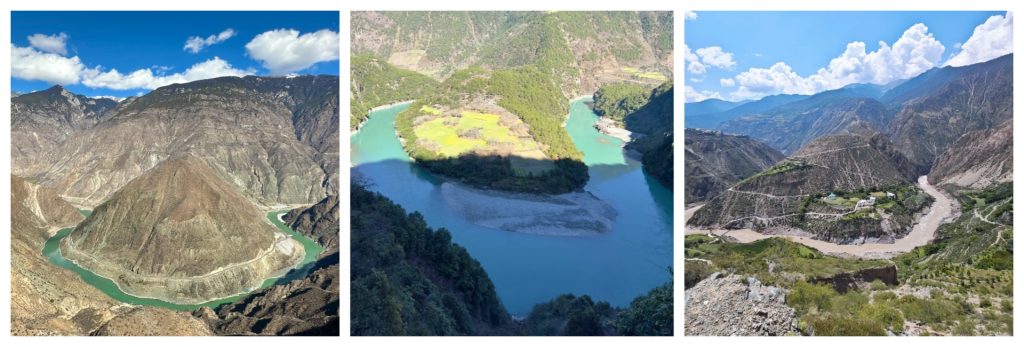 Main Attractions
Main Attractions













